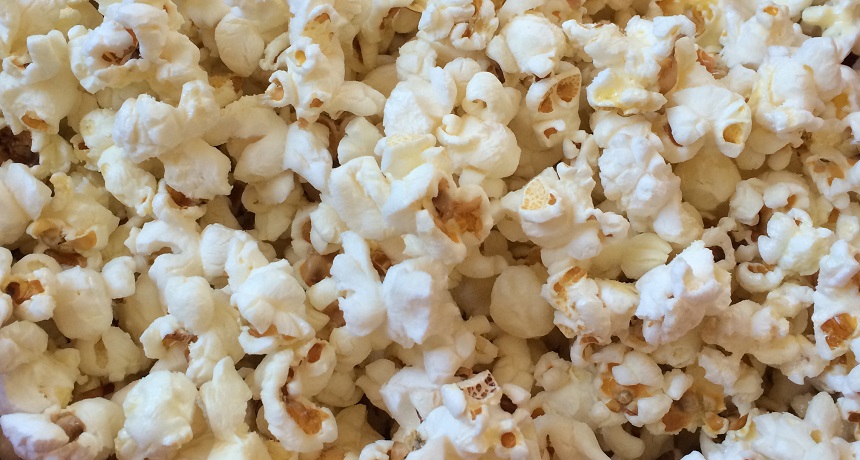How popcorn got its pop
There are special movements behind these delicious edible explosions

Fluffy popped corn is the result of tiny explosions that shoot springy legs of starch out of a tough outer hull.
B. Brookshire/SSP
The next time you pop corn on the stove for your movie night, keep a close eye on the kernels. A piece of corn heats up and begins to swell. Suddenly — POP! A tiny seed becomes a big, airy puff of corn.
Humans have been popping corn for centuries. But exactly how this explosion occurs wasn’t quite clear. Now, two scientists have identified the missing stages —and designed an experiment that you can try for yourself. All it took was an oven, a slow motion camera and a lot of popping corn.
“We were interacting with scientists who were using high-speed cameras to look at water droplets,” says Emmanuel Virot. He studies the mechanics — or how things move — of food at the École Polytechnique in Palaiseau, France. “We wanted to play with the high-speed camera, too, and use it to study plants.” As the scientists looked around for plants to study, they thought about popcorn. “We didn’t know why it was jumping the way it does when it pops,” he explains. As it explodes outward, the corn also pops up, right into your face if you don’t watch out.
Virot and another food scientist, Alexandre Ponomarkenko, also at the École Polytechnique, wanted to know what causes that jumping motion.
The two scientists took pieces of microwave popcorn and placed them in an oven. It had been preheated to a specific temperature, between 130° and 210° Celsius (266° to 410° Fahrenheit). Then they waited to see how many kernels popped. All the while, they filmed the action with a high-speed camera.
Corn kernels have a hard hull made of cellulose — long chains of sugar that form the cell walls of plants. Cellulose conducts heat well. But it also can be very tough.
It turns out that when you turn up the heat, a cellulose wall is no match for the pressure of steam. Each popcorn kernel contains a tiny amount of water in liquid form. As its temperature rises, that water turns to steam. This gas expands inside the kernel. That increases the pressure pushing out against the cellulose wall.
At 180 °C (356 °F), the pressure was just too much. The tough cellulose wall broke and the pressure from the rapid expansion of the vapor caused the corn to burst inside out. Left behind was a fluffy piece of popcorn.
“[It’s an] example of fast movements driven by the slow buildup and rapid release – in this case, of steam,” says Lakshminarayanan Mahadevan. He is a mathematician at Harvard University in Cambridge, Mass. By knowing the boiling temperature of water, the gas constant for the steam and the thickness of a kernel’s hull, the scientists came up with a computer program that helped them determine the perfect temperature for popping corn: 180 °C (356 °F).
They also examined the biomechanics of popping corn. Biomechanics is the study of how living things move. The scientists showed that the movement of a popping kernel is halfway between a seed and a muscle. Some plant seeds burst out of their hulls in a movement called “shattering.” Seed shattering is a good mechanism for a plant. It ensures the seeds go as far away from the parent plant as possible. That will give the new plants the room they need to grow. When popcorn begins to explode out of its hull, it resembles that shattering dispersal of seeds.
But it also behaves a little bit like an animal’s muscle. The fluffy parts of popcorn consist of stretched out chains of starch (a carbohydrate made from long chains of sugar molecules). The long chains are arranged like a spring, squeezed tightly inside the kernel. When the corn pops, the springs of starch snap outward, powering the popcorn’s leap. It’s similar, Virot says, to the way leg muscles let an animal jump.
The researchers designed their experiment specifically so that students might do their own experiments to find the popping temperature of corn. “With a simple experimental setup, we can show a classroom many concepts of physics (temperature, pressure, fracture, elasticity, biology),” says Virot. “This literally gives an appetite for science!” Students could try their own version of the experiment, he says, and compare their results.
All you need is popcorn, a way to determine temperature and an oven or stove. I’m up to the challenge. In a few days, I’ll post the results of my own corn popping experiment.
Follow Eureka! Lab on Twitter
Power Words
(for more about Power Words, click here)
biomechanics The study of how living things move, especially of the forces exerted by muscles and gravity on the skeletal structure.
cellulose A type of fiber found in plant cell walls. It is formed by chains of glucose molecules.
gasconstant A constant number, usually abbreviated R, which relates energy and temperature in physics equations. R is 8.3144621 Joules/mol Kelvin.
glucose A simple sugar that is an important energy source in living organisms. It is half of the molecule that makes up table sugar (also known as sucrose).
mechanics The study of how things move.
pressure Force applied uniformly over a surface, measured as force per unit of area.
starch A type of carbohydrate made from long chains of sugar. It contains a lot of energy in its chemical bonds that animals can use to power their activities.







